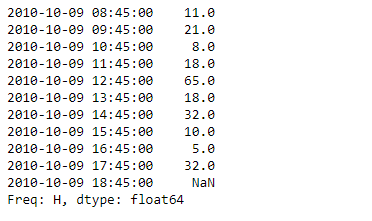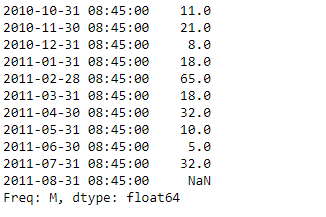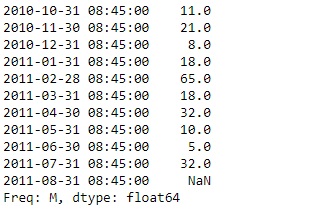Python Pandas Series.at_time()
Pandas系列是一个带有轴标签的一维ndarray。标签不需要是唯一的,但必须是一个可散列的类型。该对象支持基于整数和标签的索引,并提供了大量的方法来执行涉及索引的操作。
Pandas Series.at_time()函数用于在给定的系列对象中选择一天中特定时间的值(例如9:30AM)。
语法: Series.at_time(time, asof=False, axis=None)
参数:
time: datetime.time 或字符串
axis: {0或’索引’,1或’列’},默认0
返回: values_at_time : 与调用者类型相同
例子#1:使用Series.at_time()函数来返回给定系列对象中一天中特定时间的数值。
# importing pandas as pd
import pandas as pd
# Creating the Series
sr = pd.Series([11, 21, 8, 18, 65, 18, 32, 10, 5, 32, None])
# Create the Index
index_ = pd.date_range('2010-10-09 08:45', periods = 11, freq ='H')
# set the index
sr.index = index_
# Print the series
print(sr)
输出 :

现在我们将使用Series.at_time()函数来返回给定系列对象中一天中特定时间的数值。
# return values at particular time of the day
result = sr.at_time(time = '13:45:00')
# Print the result
print(result)
输出 :

正如我们在输出中看到的,Series.at_time()函数已经成功地返回了给定系列对象中一天中特定时间的值。
示例#2 :使用Series.at_time()函数来返回给定系列对象中一天中特定时间的数值。
# importing pandas as pd
import pandas as pd
# Creating the Series
sr = pd.Series([11, 21, 8, 18, 65, 18, 32, 10, 5, 32, None])
# Create the Index
# apply monthly frequency
index_ = pd.date_range('2010-10-09 08:45', periods = 11, freq ='M')
# set the index
sr.index = index_
# Print the series
print(sr)
输出 :

现在我们将使用Series.at_time()函数来返回给定系列对象中一天中特定时间的数值。
# return values at particular time of the day
result = sr.at_time(time = '08:45:00')
# Print the result
print(result)
输出 :

正如我们在输出中看到的,Series.at_time()函数已经成功地返回了给定系列对象中一天中特定时间的值。系列对象中的所有值都已被返回,因为它们的时间值等于传递的时间。
 极客教程
极客教程